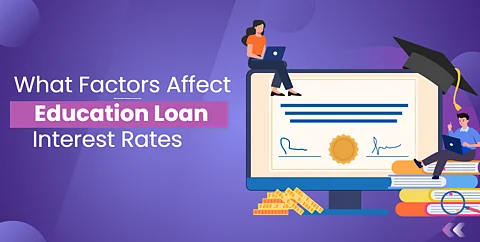
- News
- Women
- Magazine
- IndustryIndustry
- InsightsInsights
- Success Stories
- PublishPublish
- ContactContact
- Media KitMedia Kit

Education loans serve as crucial financial support for students pursuing higher education within India or internationally. While these loans make education accessible, understanding the factors that influence their interest rates are essential to making informed financial decisions. In this article, you will learn about the factors affecting education loan interest rates.
Below are the factors that affect education loan interest rates.
Education loans come in various forms, primarily secured and unsecured loans. Secured loans are mostly offered against the borrower's collateral, either property or a fixed deposit. Secured loans offer interest rates lower than unsecured loans, which in turn attract higher rates because lenders take a higher risk.
The principal amount of the education loan also affects the interest rate. Loans with higher principal amounts, particularly for studying abroad or in prestigious institutions, may attract lower rates if the course has strong job prospects. While on the other hand, smaller loan amounts for less renowned institutions may come with slightly higher rates due to perceived risk.
The nature of the course and the reputation of the institution play a significant role. Loans provided to students attending professional courses in reputed institutes such as engineering, medicine, or management often have lower interest rates. This is because the employability of the students is much better with these courses or institutions, thereby reducing the risk of default.
A credit score that indicates discipline in managing credit and general financial stability will affect the offered interest rate. An applicant whose credit rating is above 750 generally will have to pay a lesser interest rate than one with a low score. If the student has no or little credit score, consideration of the co-borrower (usually a parent or guardian) is considered.
Since education loans often involve a co-borrower, their financial stability plays a crucial role. Factors such as the co-borrower’s income, credit score, and existing liabilities affect the lender's decision. A financially stable co-borrower reduces the risk for lenders, potentially leading to lucrative interest rates.
The repayment period for the education loan can influence the interest rate. Shorter tenures generally attract lower interest rates as lenders recover their funds faster, reducing their risk exposure. Longer tenures, while offering lower monthly EMIs, might come with slightly higher rates to compensate for the extended risk.
Macroeconomic factors such as inflation, market liquidity, and the Reserve Bank of India’s (RBI) monetary policy directly impact education loan interest rates. For instance, during periods of high inflation or when the RBI increases repo rates, lending institutions may hike their interest rates. Conversely, during low inflation or economic slowdowns, rates may be lowered to encourage borrowing.
Several schemes launched by the government aim to make education loans cheap, especially for economically weaker sections. Under such plans, students can also avail loans at subsidised rates of interest. As an example, through the Central Sector Interest Subsidy, the Indian government waives the interest during the moratorium period for eligible students.
Each lender has its own internal policies, which include risk assessment methods, funding costs, and profit margins. Public sector banks often offer slightly lower rates for education loans compared to private banks and non-banking financial companies (NBFCs). Additionally, some lenders provide discounts to female students or for loans taken from partner institutions.
Repayment flexibility is a significant factor when evaluating an education loan. Many lenders offer moratorium periods, allowing students to start repayment only after completing their course or securing a job. This grace period provides a buffer for students to stabilise their finances before beginning repayments. Additionally, some financial institutions offer step-up repayment plans, where the EMIs increase gradually over time, aligning with the borrower’s expected rise in income.
Some lenders provide specific interest rate discounts for particular situations, like a student with excellent academic results or studying in high-demand fields. Women borrowers also get concessionary rates under various initiatives that enhance female participation in education.
The interest rate of education loans is determined by a mix of borrower-specific, lender-specific, and broader economic factors. Students and their families can make better decisions and negotiate a favourable term by understanding these key factors. With the right lender, and a strong financial profile, alongside government schemes, borrowers can achieve competitive interest rates to access quality education.
Follow us on Google News
